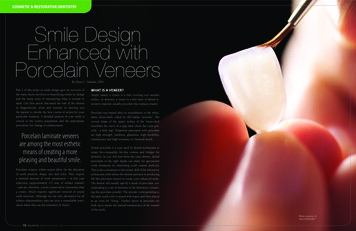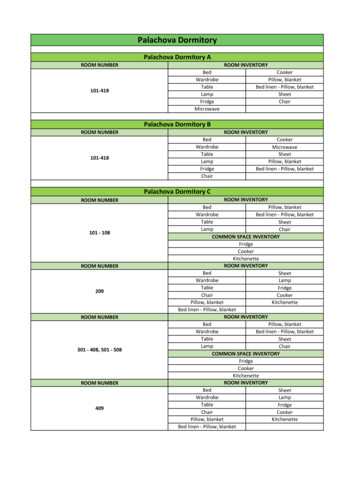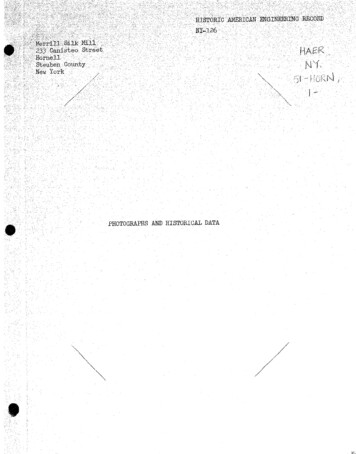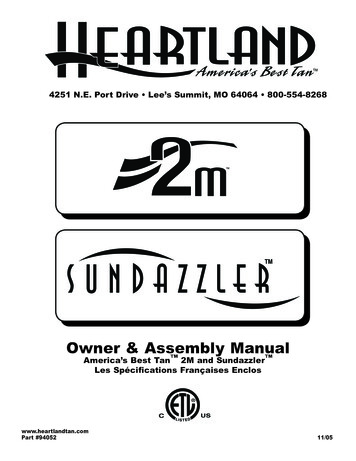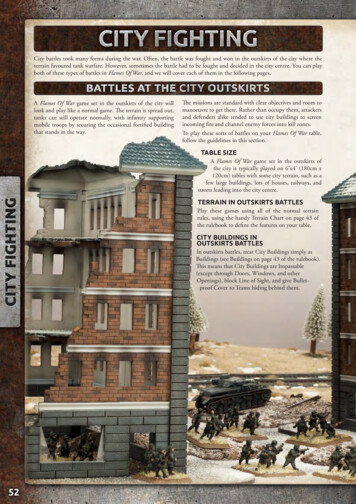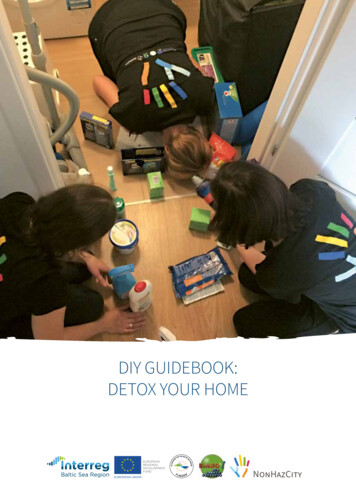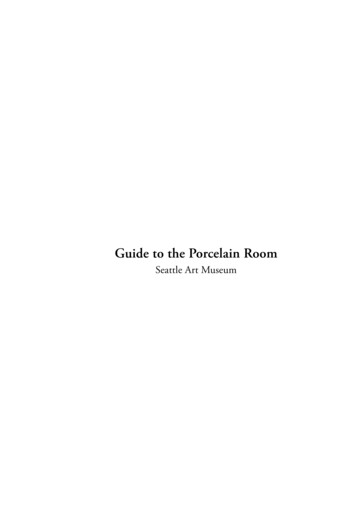
Transcription
Guide to the Porcelain RoomSeattle Art Museum
Guide to the Porcelain RoomSeattle Art Museum
Tiepolo’s AllegoryEnduring fame—the goal of so many figures in history—was the promise of art.The image that crowns the Porcelain Roomwas originally painted on the ceiling of the Porto family palacedesigned by Andrea Palladio (1508–1580), the great Renaissancearchitect, in the town of Vicenza. It was commissioned fromTiepolo, the greatest Venetian artist of the eighteenth century,to celebrate the bravery of the Porto family, which was notedfor generations of military accomplishments. Tiepolo first made afluid oil sketch, here displayed on the wall, to show to his patronbefore commencing work on the final painting.Tiepolo designed an allegory in whichFame crowns the golden-robed figure ofValor with a laurel wreath, as Time watcheshelplessly from the shadows below, his scythe overturned. Thefresco was removed from the palace in the early part of the twentieth century, transferred to canvas, and sold to a German collector.In 1951 the Kress Foundation bought the fresco; the Foundationhad already purchased the sketch for it in 1948. A painting thatoriginally was an integral part of a building thus became a mobilework of art, ending up in Seattle and spreading the fame of thePorto family more widely than they could ever have imagined.— Chiyo IshikawaDeputy Director of Art andCurator of European Painting and SculptureSeattle Art MuseumThe Triumph of Valor over Time, ca. 1757Fresco transferred to canvasGiovanni Battista TiepoloItalian, Venice, 1696–1770Gift of the Samuel H. Kress Foundation, 61.170The Triumph of Valor over Time(preparatory sketch), ca. 1757Oil on canvasGiovanni Battista TiepoloItalian, Venice, 1696–1770Gift of the Samuel H. Kress Foundation, 61.169
The Porcelain Roomat theSeattle Art MuseumOver the past thirty years, selectionsfrom the Seattle Art Museum’s premiercollection of eighteenth-century European porcelain have been exhibited indiscrete settings—on a tea table, in aperiod cabinet, and in a museum case.Because recent generations have come toknow porcelain mainly in the form of relatively inexpensive dinnerware and cheap knickknacks, it is difficult to convey a sense ofthe exalted position that early porcelain held and the intriguingstories surrounding it. In tribute to porcelain’s beauty and honored tradition, the Seattle Art Museum has created its PorcelainRoom. This integrated architectural and decorative scheme displays European and Asian porcelain that evokes a time when porcelain was a highly treasured art and valuable trade commodity.Forgoing the standard museum installation arranged bynationality, manufactory, and date, our porcelain is grouped bycolor and theme. One pair of niches glows with vibrant red glazesand decoration. In another pair, the beauty of the undecoratedmaterial can be appreciated in a chorus of “whites” that exemplifythe variety of porcelain pastes. Chinoiseries, innovative Europeandecorative motifs depicting exotic figures in fanciful Asian scenes,fill one pair of niches. Birds, bugs, and beasts inhabit another pair.Because porcelain could be molded and cast into lively, sculptural, asymmetrical curving shapes, it was the perfect medium forthe rococo style. Porcelain in this style, displayed in the nichesbetween the doorways, embodied the essence of European tastein the mid eighteenth century.A Brief History of PorcelainToday we encounter the presence of porcelain—the thin, whitebodied, ceramic ware that resonates when tapped— everywherein our daily lives, from tableware to bathroom fixtures to space shuttle tiles. Over time, we have lost the awareness that for centuries, porcelain was a rarity, a treasured material producedexclusively in Asia.Porcelain’s development in China around a.d. 600 was a technological feat resulting from the combination of the ability to firekilns at the high temperatures of 1250–1400 C with the discovery of the materials kaolin clay and porcelain stone. In the thirteenth century, porcelain production was elevated to another levelwhen the clay and the stone were combined, creating finer, more durable wares. The kendi, or water vessel (no. 1, Early Porcelain,left niche), is an ex ample of early white ware made in the northof China from kaolin clay. The small bowl (no. 2, Early Porcelain,left niche) represents the southern Song dynasty qingbai ware,with its characteristic bluish-toned glaze, which was created fromporcelain stone–based clay. The innovation at Jingdezhen of mixing kaolin with porcelain stone, rich in quartz and mica, created aceramic ware that became regarded as true porcelain, and therebymade Jingdezhen the porcelain capital of the world. Representedby many works in this room, Jingdezhen production was reveredfor its combination of hardness, impermea bility, whiteness, translucence, and beautiful glazes. Chinese porcelain assumed a role asone of the world’s most desired trade goods.Porcelain joined the stream of exoticrarities, such as silk and spices, thatbegan to arrive in Europe over the difficult land routes, known collectively asthe Silk Road, that looped across central Asia, linking China and the West.Porcelains were respected treasures, coveted princely gifts considered objects of wonder and imbued withmagical qualities—many believed that porcelain would crackleand discolor if it came into contact with poison. Trade increasedwhen the Portuguese explorer Vasco da Gama discovered a searoute to the East, returning from his journey in 1499 with fineexamples of porcelain. The sea offered safer transport for fragilewares than did the caravans and other rigors of the Silk Road. Asmore trade routes developed, larger and faster ships plied globalwaters in the seventeenth century, and even greater quantities ofporcelain arrived in Europe, resulting in a phenomenon knownas Chinamania.The arrival of brightly enameled porcelain from Japan (no. 5,Early Porcelain, left niche), first produced in the early seventeenthcentury, along with glowing blue-and-white and luminous whitewares from China, inspired a European trend toward integratingporcelain and interior design. In palaces and homes of the aristocracy and the rising merchant class (made wealthy by trade), roomslined with displays of porcelain from floor to ceiling became opulent, delightful showplaces. The large blue-and-white dish with itspainted image of an aggressive dragon (no. 10, Blue-and-White,right niche) is the type of ware that graced European porcelainrooms.The porcelain room culminated in the porcelain palace withan installation conceived by Augustus the Strong (1670–1733),Elector of Saxony and King of Poland. Called the JapanischesPalais, it was designed to hold his prized collection of more than20,000 Chinese and Japanese porcelains. The small Japanese dish(no. 5, Early Porcelain, left niche) bears a number that identifiesit as a piece destined for Augustus’s Japanese Palace.As vast sums were drained from European royal coffers tobuy Asian porcelain, aristocratic patrons all over Europe fundedresearch projects to reproduce the elusive formula for Chineseand Japanese porcelain. Augustus the Strong finally claimed thathonor. Under his aegis, an unlikely pair—a gentleman scientist,Ehrenfried Walther von Tschirnhaus, and a renegade alchemist,Johann Friedrich Böttger, who had been attempting to turn heavymetals into gold—collaborated to produce a formula for porcelain. Their early ware contained alabaster and is known today asBöttger porcelain (no. 8, Early Porcelain, left niche). Eventually,their formula evolved into what became known as hard-paste porcelain (no. 11, Early Porcelain, left niche), a mixture of kaolin anda feldspathic porcelain stone. In the second decade of the eighteenth century, a millennium after the Chinese first produced awhite, thin, translucent ware, Europe’s first true porcelain factorywas established at Meissen, Germany. Its porcelain was popularlyknown as “white gold.”Europe’s Age of Porcelain in the eighteenth century began askings, electors, and princes eyed the porcelain produced at Meissen in Saxony and demanded their own porcelain manufactories.
A flurry of European porcelain ventures began as workers defectedfrom Meissen, where Augustus the Strong, who wanted to keepthe secret of porcelain production from aristocratic rivals, hadheld them virtual prisoners. Patrons derived great prestige fromtheir porcelain manufactories, founded as the secret inevitablyleaked. The inspiration and influence of dynastic marriages further strengthened and spread porcelain enterprises throughoutEurope. After a granddaughter of Augustus the Strong marriedCharles, King of Naples and the Two Sicilies, a Naples porcelainmanufactory was founded in 1743 on the grounds of the couple’sroyal palace at Capodimonte (no. 28, West Meets East, rightniche).Throughout the eighteenth century, porcelain productioncontinued to flourish under imperial patronage in China and asprincely enterprises in Europe. Porcelain with luminous, evenlyapplied single-color glazes was a great technological achievementof the officially supervised Jingdezhen kilns, and these wares werereserved for use by the emperor and his court (no. 9, Blue, leftniche); these bowls bear the reign mark of the Yongzheng emperor.Porcelain was à la mode at the French court. The flower vase(no. 10, Blue, left niche), graced the mantelpiece of Madame dePompadour, the powerful and influential mistress of King LouisXV, and a chief patroness of the arts.Porcelain production in England was fully under way by1745. The English nobility never embraced the idea of establishing porcelain manufactories for prestige. Artisans and merchantsin private commercial businesses developed porcelain enterprisesin England as an important part of the trade in luxury goods (nos.17–21, Early Porcelain, left niche). Most English porcelain is madeof a soft paste created from a fine clay mixed with frit, a fused,glassy material that is powdered and added to the clay. It wasfired at around 1250 C, a lower temperature (“soft” firing) thanhard-paste porcelain. Three English cups (nos. 11–13, West MeetsEast, left niche) are proof that intriguing mysteries constantlyemerge in the world of porcelain study. Made of hard-paste porcelain, they were created around 1743–44, a quarter of a centurybefore anyone believed that the British were making a hard-pasteware. The deposits of kaolin clay necessary for the production ofhard-paste porcelain had not yet been unearthed in Britain at thistime, but it has long been known that a twenty-ton load of kaolinwas transported from the Carolinas in America to London in1743–44. An early patent for a porcelain formula describes this clay:“The material is an earth, the produce of the Chirokee nation inAmerican, called by the natives unaker.” Only thirty-five to fortyporcelains, including these cups, have been recognized as beingpart of the rare group of wares produced under this patent. Forreasons yet unknown, this enterprise was short-lived, and its creators, Edward Heylyn and Thomas Frye, moved on to establish inLondon the Bow Porcelain Manufactory of New Canton in 1747.The pair of white birds (no. 11, Birds, Bugs, and Beasts, left niche)was recorded at the Bow manufactory as herons, but they wereactually inspired by Asian depictions of the mythical phoenix,evoking Europe’s continuing fascination with the exotic East.The CollectorsThe Porcelain Room weaves together several grand collecting traditions in Seattle. Dr. Richard Fuller (1879–1976), founder anddirector of the Seattle Art Museum for forty years, establishedthe museum’s original Asian porcelain collection. Members of theSeattle Ceramic Society, founded by Blanche M. Harnan in themid 1940s, focused on collecting European porcelain comparableto Dr. Fuller’s Asian porcelain, and worthy of being exhibited atthe Seattle Art Museum. The credit lines listed in this publicationrecognize the many individuals active in the Society who generously donated their treasured porcelain to the museum. Especiallynoteworthy are Martha and Henry Isaacson, whose gift of some350 objects provided the foundation of our collection of European porcelain. Dorothy Condon Falknor, another member of theSociety, provided rare Italian porcelain. Some European porcelainin this room represents holdings formed by individuals with a passion for porcelain who collected independently. Notable amongthese are Dr. and Mrs. Ulrich Fritzsche, with their collection ofFrench porcelain, and Kenneth and Priscilla Klepser, with theirlarge, comprehensive collection of Worcester porcelain. Both ofthese collections are essential parts of the Porcelain Room.—Julie EmersonThe Ruth J. Nutt Curator of Decorative ArtsSeattle Art Museum
Early Porcelain left1Water vessel (kendi), 7th century, Chinese, Tang dynasty(618–908), Northern white ware, hard paste. The earlyporcelain in northern China is not perfectly white; the glazeoften has a yellow or green tint.1Eugene Fuller Memorial Collection, 49.1402Bowl, 960–1279, Chinese, Song dynasty, Jiingdezhen,qingbai ware, hard paste. The bluish-toned glaze on qingbaiis thin and pools in the incised decoration.Thomas D. Stimson Memorial Collection, Gift of Mrs. Thomas D. Stimson, 36.8332Bowl, late 12th–13th century, Chinese, Jin dynasty(1115–1234), Ding ware, hard paste4Gift of Mrs. Frank H. Molitor, in memory of her mother Mrs. Stanley A. Griffiths, 74.94Scalloped bowl, 960–1127, Chinese, Song dynasty (960–1279),Ding ware, hard paste5Gift of Mrs. Ralph J. Sheafe, 61.1855Ten-sided dish, early 18th century, Japanese, Arita, hard pasteGift of Martha and Henry Isaacson, 76.986Hexagonal tea caddy, ca. 1710–13, German, Meissen,unglazed Böttger stoneware. A German physicist, Count6von Tschirnhaus (1651–1708), and an alchemist, Johann Böttger(1682–1719), became the two key players during the final stagesof the European quest for true porcelain. Their experimentsproduced a dense, high-fired red stoneware—steps toward theporcelain formula they soon devised.89Gift of Martha and Henry Isaacson, 69.1777710Hexagonal tea caddy, ca. 1710–13, German, Meissen,Böttger stoneware with black glaze11Gift of Martha and Henry Isaacson, 69.1788Hexagonal tea caddy, ca. 1715–20, German, Meissen,Böttger porcelain. The early formula in Germany produced acreamy white porcelain. Because porcelain shrinks more in firingthan stoneware, the porcelain tea caddy is smaller than the unglazed stoneware caddy from the same mold.12Gift of Martha and Henry Isaacson, 69.1839Head of Apollo, ca. 1710–13, German, Meissen, Böttgerstoneware. From a model by Paul Heermann (1673–1732)13aGift of Martha and Henry Isaacson, 69.1791013bBust of Duke of Cumberland, ca. 1750–53, English, Chelsea,soft pasteGift of Martha and Henry Isaacson, 76.21711Cup and double-handled saucer, ca. 1730, German, Meissen,hard paste. The cup’s AR monogram stands for Augustus Rex,Elector of Saxony and King of Poland (1670–1733).13c13e13dGift of Martha and Henry Isaacson, 69.19812Bowl, ca. 1728, German, Meissen, hard pasteGift of Martha and Henry Isaacson, 69.2131313fPartial tea and coffee service, ca. 1730–35, German, Meissen,hard paste13h13gGift of Mr. and Mrs. Robert S. Nichols, 91.101.1–.10Tea caddy b Sugar bowl c Teapot and stand d CoffeepotHot water jug f Saucer g Tea bowl h Saucer14 Tea bowl and saucer, ca. 1765–75, Italian, Cozzi, hard pasteae1415Gift of the Charlotte Page Collection, 99.13615Saucer, ca. 1720–27, Italian, Vezzi, hard pasteDorothy Condon Falknor Collection of European Ceramics, 87.142.12616Sugar bowl, ca. 1720, German, Meissen, Böttger porcelainDecoration attributed to Ignaz Preissler, Breslau (present-dayWroclaw, Poland), ca. 1725–30Gift of Martha and Henry Isaacson, 69.173171617Beaker, ca. 1744–49, English, Chelsea, soft pasteGift of Martha and Henry Isaacson, 55.79182118Beaker, ca. 1744–49, English, Chelsea, soft paste20Gift of Martha and Henry Isaacson, 76.2081919Helmet jug, ca. 1752, English, Worcester, soft pasteKenneth and Priscilla Klepser Porcelain Collection, 94.103.320Goat and bee jug, ca. 1745–49, English, Chelsea, soft pasteGoat and bee jugs represent some of the earliest productions ofChelsea, the first established English porcelain manufactory. Thesejugs have always been admired. The thin, fragile legs of the bees havesurvived intact for over 250 years, indicating that enormous care wastaken to preserve these two jugs.22a22c22bGift of Martha and Henry Isaacson, 69.16221Goat and bee jug, ca. 1745–49, English, Chelsea, soft pasteGift of Martha and Henry Isaacson, 76.20722Partial tea service, ca. 1744, Chinese, export ware,hard paste. With arms of Lady Charlotte Beauclerk, grand-daughter of Charles II; she married John Drummond in 1744.Gift of Martha and Henry Isaacson, 76.115.1–.7aMilk jug b Teapot c Tea bowl d Tea bowls and saucers22d22d22d22d
Early Porcelain right1 Armorial plate, ca. 1740, Chinese, export ware, hard pasteWith arms of the Dutch families Van Schoonhoven of Rotterdam andGeraerds of Haarlem, in joined crests. Thymon van Schoonhoven andElisabeth Geraerds married in 1739.Gift of Martha and Henry Isaacson, 76.11021Tea bowl with saucer, ca. 1720, German, Meissen, Böttgerporcelain. Decoration attributed to the Seuter family workshop,Augsburg, ca. 1725–45Gift of Martha and Henry Isaacson, 69.2115243 Tankard, ca. 1720, German, Meissen, Böttger porcelainDecoration attributed to Ignaz Preissler, Breslau (present-dayWroclaw, Poland)Gift of Martha and Henry Isaacson, 69.17043Tea bowl, early 18th century, Chinese, export ware, hard pasteGift of Martha and Henry Isaacson, 76.1175Beaker, ca. 1730, Austrian, Du Paquier, hard pasteBlanche M. Harnan Ceramic Collection, 66.85667Teapot, ca. 1715–20, German, Meissen, Böttger porcelainDecoration attributed to the Auffenwerth family workshop, Augsburg,ca. 1730–40Gift of Martha and Henry Isaacson, 69.1967Tripod creamer and stand, ca. 1726–30, German, Meissen,Böttger porcelainGift of Martha and Henry Isaacson, 69.1948Plate, ca. 1745–50, German, Meissen, hard pasteFrom the Paris and Béthune ServiceDorothy Condon Falknor Collection of European Ceramics, 87.142.1059Bowl, ca. 1715–20, German, Meissen, Böttger porcelainDecorated outside the manufactory, ca. 17308Gift of Martha and Henry Isaacson, 69.19110 Teapot, ca. 1750–51, French, Vincennes, soft pasteLid: ca. 1753–60, Vincennes /Sèvres11Gift of Dr. and Mrs. Ulrich Fritzsche, 99.71911Sugar spoon, 1752–54, French, Vincennes, soft pasteGift of Dr. and Mrs. Ulrich Fritzsche, 2005.1771012Tea bowl and saucer, early 18th c., Chinese, Dehua ware(called blanc de chine in Europe), hard paste. Decorated in France,1720s, perhaps by a Parisian jewelerDorothy Condon Falknor Collection of European Ceramics, 87.142.9813141213 Bowl, ca. 1735–40, German, Meissen, hard pastePainted by Franz Mayer of Pressnitz, Bohemia, ca. 1735–40Dorothy Condon Falknor Collection of European Ceramics, 87.142.9914Tankard, 1728–30, German, Meissen, hard pasteGift of William H. Lautz, 55.94161515 Tea bowl and saucer, ca. 1720s, German, MeissenTea bowl: hard paste; saucer: Böttger porcelain17Painting attributed to the Seuter family workshop,Augsburg, ca. 1725–45Gift of Martha and Henry Isaacson, 76.2581618Bowl, ca. 1770, German, Fulda, hard pasteGift of Mrs. Frank H. Molitor, 86.27917Tea bowl and saucer, ca. 1725–30, German, Meissen,hard pasteGift of Martha and Henry Isaacson, 76.263192018Cup and saucer, 1780–88, German, Fulda, hard pasteGift of Martha and Henry Isaacson, 76.26819Cup and saucer, ca. 1780, German, Thuringian, hard pasteDorothy Condon Falknor Collection of European Ceramics, 87.142.1222120Cup and saucer, 1780–88, German, Fulda, hard pasteGift of Martha and Henry Isaacson, 76.27221Bowl, ca. 1756, English, Worcester, soft pasteKenneth and Priscilla Klepser Porcelain Collection, 94.103.180222322Saucer, ca. 1756–58, English, Worcester, soft pasteKenneth and Priscilla Klepser Porcelain Collection, 94.103.1722423Cream jug, ca. 1754–55, English, Worcester, soft pasteKenneth and Priscilla Klepser Porcelain Collection, 94.103.17824Stand for a finger bowl, ca. 1760–62, English, Worcester,soft pasteKenneth and Priscilla Klepser Porcelain Collection, 94.103.18325262527Tea bowl and saucer, ca. 1768, English, Worcester, soft pasteKenneth and Priscilla Klepser Porcelain Collection, 94.103.18526Teapot, ca. 1760–62, English, Worcester, soft pasteKenneth and Priscilla Klepser Porcelain Collection, 94.103.17627Kenneth and Priscilla Klepser Porcelain Collection, 94.103.1792829Tea bowl and saucer, ca. 1754–55, English, Worcester,soft paste2830Teapot, ca. 1762, English, Worcester, soft pasteKenneth and Priscilla Klepser Porcelain Collection, 94.103.17729Bowl, ca. 1756–58, English, Worcester, soft pasteKenneth and Priscilla Klepser Porcelain Collection, 94.103.17330Bowl, ca. 1760, English, Worcester, soft pasteKenneth and Priscilla Klepser Porcelain Collection, 94.103.175
Chinoiserie left1Fork and knife handles, ca. 1730, Austrian, Du Paquier,hard pasteGift of Mrs. Will Otto Bell, 57.1612Knife handle, ca. 1735–40, German, Meissen, hard pasteDorothy Condon Falknor Collection of European Ceramics, 87.142.73Knife handle, ca. 1760, German, Berlin, hard pasteDorothy Condon Falknor Collection of European Ceramics, 87.142.1124Knife handle, ca. 1745–48, French, Villeroy, soft pasteDorothy Condon Falknor Collection of European Ceramics, 87.142.45Knife handle, ca. 1740–50, French, probably Saint-Cloud,soft paste3Dorothy Condon Falknor Collection of European Ceramics, 87.142.567Knife handle, ca. 1745–50, French, Chantilly, soft paste1Knife handle, ca. 1740–45, French, Villeroy, soft paste12Dorothy Condon Falknor Collection of European Ceramics, 87.142.38Beaker, ca. 1747–50, Italian, Capodimonte, soft paste111Dorothy Condon Falknor Collection of European Ceramics, 87.142.48962Dorothy Condon Falknor Collection of European Ceramics, 87.142.8754Tea bowl, ca. 1735, German, Meissen, hard pasteDorothy Condon Falknor Collection of European Ceramics, 87.142.10710Teapot, ca. 1723–25, German, Meissen, hard paste10Dorothy Condon Falknor Collection of European Ceramics, 87.142.97111316Tea bowl, ca. 1770, Italian, Cozzi, hard pasteGift of the Charlotte Page Collection, 99.12712Tea bowl, ca. 1780, Italian, Le Nove, hard paste9Gift of the Charlotte Page Collection, 99.1261315Vase and cover, ca. 1770, German, Volkstedt, hard paste18Gift of Martha and Henry Isaacson, 76.28014Saucer, ca. 1723–25, German, Meissen, hard pasteDorothy Condon Falknor Collection of European Ceramics, 87.142.9215Tea bowl and saucer, ca. 1730–35, German, Meissen,hard paste8Saucer, ca. 1730–35, German, Meissen, hard pasteDorothy Condon Falknor Collection of European Ceramics, 87.142.95172014Gift of Dr. and Mrs. S. Allison Creighton, 95.95161917Tea bowl and saucer, ca. 1765–70, Italian, Doccia,hard pasteGift of the Charlotte Page Collection, 99.13918Snuff bottle, 1736–95, Chinese, Qianlong period,Jingdezhen, hard paste2123Eugene Fuller Memorial Collection, 33.11719Stand (presentoire) for a broth bowl (écuelle), ca. 1725–26,German, Meissen, hard paste22Dorothy Condon Falknor Collection of European Ceramics, 87.142.10920Saucer, ca. 1725, German, Meissen, Böttger porcelain24Dorothy Condon Falknor Collection of European Ceramics, 87.142.1012125Reclining figure, ca. 1735–45, French, Saint-Cloud orpossibly Villeroy, ca. 1745, soft pasteDorothy Condon Falknor Collection of European Ceramics, 87.142.2622Tea bowl and saucer, late 18th century, Chinese,export ware, hard pasteGift of Mrs. Frank H. Molitor in honor of the museum’s 50th year, 84.6623Figure of Li Bai, 1662–1722, Chinese, Kangxi period,Jingdezhen, hard pasteEugene Fuller Memorial Collection, 45.1624272628Tea caddy, 1760–65, Spanish, Buen Retiro, soft pasteDorothy Condon Falknor Collection of European Ceramics, 87.142.6925Saucer, ca. 1735, French, Chantilly, soft pasteDorothy Condon Falknor Collection of European Ceramics, 87.142.152926 Tankard, 1726–28, German, Meissen, hard pastePainting attributed to Johann Ehrenfried Stadler (1701–1741)Gift of Martha and Henry Isaacson, 69.20427 Large plate, ca. 1725–30, German, Meissen, hard pastePainting attributed to Johann Ehrenfried Stadler (1701–1741)Gift of Martha and Henry Isaacson, 69.20328303231Tankard, ca. 1735, German, Meissen, hard pastePainting attributed to Adam Friedrich von Löwenfinck (1714–1754).Second Earl of Jersey ServiceGift of Martha and Henry Isaacson, 58.10029Octagonal bowl, ca. 1755, English, Chelsea, soft pasteGift of Martha and Henry Isaacson, 69.16530Cider jug, ca. 1754, English, Worcester, soft pasteKenneth and Priscilla Klepser Porcelain Collection, 94.103.303133Waste bowl, ca. 1768, English, Worcester, soft pasteGift of Martha and Henry Isaacson, 76.17832Teapot, ca. 1770–72, English, Worcester, soft pastePainted in the workshop of James Giles (1718–1800), LondonKenneth and Priscilla Klepser Porcelain Collection, 94.103.16833Punch bowl, ca. 1768, English, Worcester, soft pasteKenneth and Priscilla Klepser Porcelain Collection, 94.103.8234Dish, ca. 1758, English, Worcester, soft pasteKenneth and Priscilla Klepser Porcelain Collection, 94.103.4435Dish, ca. 1758, English, Worcester, soft pasteKenneth and Priscilla Klepser Porcelain Collection, 94.103.483435
Chinoiserie right1Knife handle, ca. 1745, French, Chantilly, soft pasteDorothy Condon Falknor Collection of European Ceramics, 87.142.22Knife handle, ca. 1740, French, Chantilly or Villeroy,soft pasteDorothy Condon Falknor Collection of European Ceramics, 87.142.13Knife handle, ca. 1750, French, Chantilly, soft pasteGift of Martha and Henry Isaacson, 55.93432Knife handle, ca. 1740–50, French, Villeroy-Mennecy,soft pasteGift of Dr. and Mrs. S. Allison Creighton, 92.424551Knife handle, ca. 1750, French, soft pasteDorothy Condon Falknor Collection of European Ceramics, 87.142.666Knife handle, ca. 1765–75, Italian, Doccia, hard pasteGift of the Charlotte Page Collection, 99.149779Knife and fork handles, ca. 1768–70, English, Worcester,soft pasteKenneth and Priscilla Klepser Porcelain Collection, 94.103.124.1–.27108Coffeepot, ca. 1770, English, Plymouth, hard pasteGift of Martha and Henry Isaacson, 76.2039Cup, ca. 1756–58, English, Worcester, soft pasteKenneth and Priscilla Klepser Porcelain Collection, 94.103.458101114Cream jug, ca. 1752–53, English, Worcester, soft pasteKenneth and Priscilla Klepser Porcelain Collection, 94.103.1711Mug, ca. 1752, English, Worcester, soft pasteKenneth and Priscilla Klepser Porcelain Collection, 94.103.412161512Mug, ca. 1756–58, English, Worcester, soft pasteKenneth and Priscilla Klepser Porcelain Collection, 94.103.4613Cream jug, ca. 1760–62, English, Worcester, soft pasteKenneth and Priscilla Klepser Porcelain Collection, 94.103.1881714Spoon tray, ca. 1760–62, English, Worcester, soft pasteKenneth and Priscilla Klepser Porcelain Collection, 94.103.6218132015Spoon tray, ca. 1756–58, English, Worcester, soft pasteGift of Martha and Henry Isaacson, 76.1701619Tea bowl and saucer, ca. 1762–65, English, Worcester,soft pasteKenneth and Priscilla Klepser Porcelain Collection, 94.103.18917Vase, ca. 1753, English, Worcester, soft pasteKenneth and Priscilla Klepser Porcelain Collection, 94.103.111821Bowl, ca. 1758, English, Worcester, soft pasteKenneth and Priscilla Klepser Porcelain Collection, 94.103.55211922Cream boat, ca. 1754–55, English, Worcester, soft pasteKenneth and Priscilla Klepser Porcelain Collection, 94.103.2220Waste bowl, ca. 1754, English, Worcester, soft pasteGift of Martha and Henry Isaacson, 76.18924232126Butter boats, ca. 1755–60, English, Bow, soft pasteGift of Dr. & Mrs. Bradley Rennie Harris and their children, Meghan andChristopher, in memory of Mrs. George Wellington Stoddard, 96.42.1–.22522Vase, ca. 1753, English, Worcester, soft pasteKenneth and Priscilla Klepser Porcelain Collection, 94.103.1023Saucer, ca. 1720, German, Meissen, Böttger porcelainDecoration attributed to the Seuter family workshop, Augsburg,ca. 1725–4524Gift of Dr. and Mrs. S. Allison Creighton, 95.92242728Tea bowl and saucer, ca. 1720, German, Meissen, Böttgerporcelain. Decoration attributed to the Seuter family workshop,Augsburg, ca. 1725–45Gift of Martha and Henry Isaacson, 69.2072525Chocolate cup and saucer, ca. 1720, German, Meissen, Böttgerporcelain. Decoration attributed to the Seuter family workshop,Augsburg, ca. 1725–45Gift of Martha and Henry Isaacson, 69.2082629Sugar box, ca. 1720, German, Meissen, Böttger porcelainDecoration attributed to the Seuter family workshop, Augsburg,ca. 1725–45Gift of Martha and Henry Isaacson, 55.98313027Tankard, ca. 1720, German, Meissen, Böttger porcelainDecoration attributed to the Auffenwerth family workshop,Augsburg, ca. 1730–3532Gift of Martha and Henry Isaacson, 69.1922832Coffeepot, ca. 1720, German, Meissen, Böttger porcelainDecoration attributed to the Seuter family workshop, Augsburg,ca. 1725–4532Gift of Martha and Henry Isaacson, 69.19029Covered bowl, ca. 1753, English, Bow, soft pasteBlanche M. Harnan Ceramic Collection, Gift of Seattle Ceramic Society, Unit I, 64.1363330Tea bowl and saucer, ca. 1756–58, English, Worcester,soft pasteKenneth and Priscilla Klepser Porcelain Collection, 94.103.17131Finger bowl, ca. 1760–62, English, Worcester, soft pasteKenneth and Priscilla Klepser Porcelain Collection, 94.103.18132Saucers, late 18th century, Chinese, export ware, hard pasteGift of Mrs. Charles E. Stuart, 79.116.1–.333Dish, ca. 1756–58, English, Worcester, soft pasteKenneth and Priscilla Klepser Porcelain Collection, 94.103.1703434Plate, 1756–58, English, Bow, soft pasteAnonymous gift in memory of Harold and Jean Williams, 87.9
West Meets East left1Octagonal dish, ca. 1755, English, Chelsea, soft pasteGift of Martha and Henry Isaacson, 69.1642Plate, late 17th century, Japanese, Arita, hard pasteEugene Fuller Memorial Collection, 56.12213Teapot, ca. 1753–54, English, Worcester, soft paste2Kenneth and Priscilla Klepser Porcelain Collection, 94.103.54Sa
ures in history—was the promise of art. The image that crowns the Porcelain Room was originally painted on the ceiling of the Porto family palace designed by Andrea Palladio (1508-1580), the great Renaissance . painted image of an aggressive dragon (no. 10, Blue-and-White, right niche) is the type of ware that graced European porcelain rooms.



